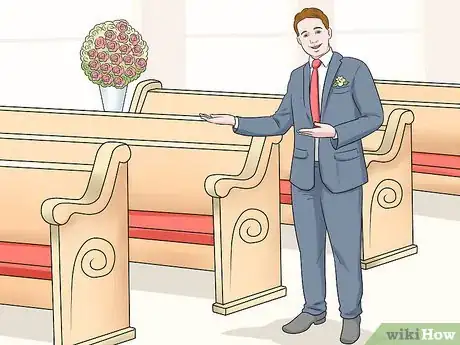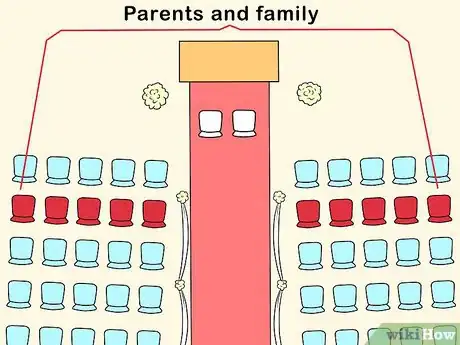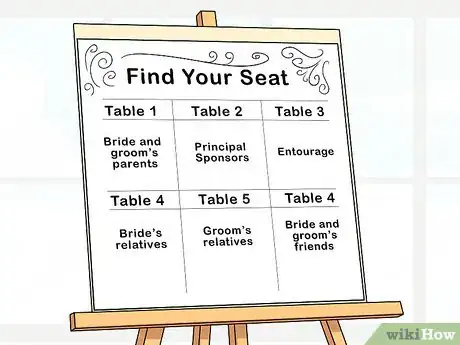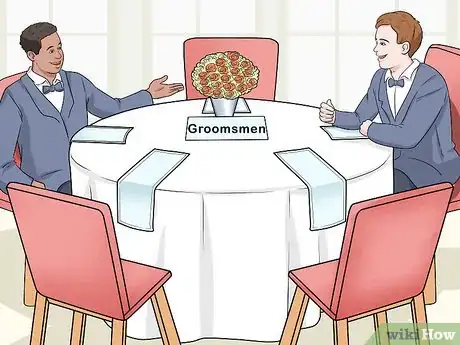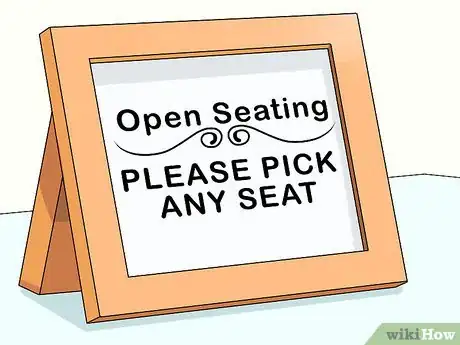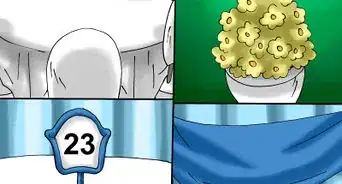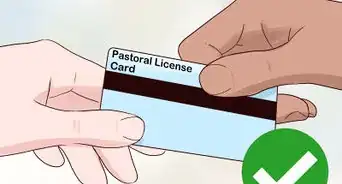This article was co-authored by Leah Weinberg. Leah Weinberg is the Owner & Creative Director of Color Pop Events — a New York City-based wedding planning company that focuses on the details and lives in the logistics. Now in her 6th year of running Color Pop, Leah’s colorful work and party planning tips have been published online and in print with Vogue, Bravo, Thrive Global, Glamour, Marie Claire, Martha Stewart Weddings, Martha Stewart Living, The Knot, Buzzfeed and more. Leah is also the author of the newly-published book, The Wedding Roller Coaster.
There are 9 references cited in this article, which can be found at the bottom of the page.
This article has been viewed 144,197 times.
Even at the most well-planned wedding, the seating situation can be confusing. Traditionally, it’s the responsibility of the ushers to show guests of the bride and groom to their seats. If they’re all tied up, however, or if you happen to arrive late, there are a few simple guidelines that will help you find an appropriate spot without causing a disruption. Leave the first three or four rows open to family and close friends, then fill in one of the remaining seats from front to back on either the bride or groom’s side.
Steps
Being Seated for the Ceremony
-
1Have an usher show you to your seat. The ushers are there to seat guests and control the flow of foot traffic into the venue as people start arriving. Let the usher know whether you’re a guest of the bride or the groom. According to tradition, the bride’s side is to the left of the aisle when facing the altar, while the groom’s side is to the right.[1]
- If you don’t have a preference for where to sit, you can fill in an empty seat on either side of the aisle.[2]
- Guests of honor may be assigned a special seat. In this case, you’ll present a token (like a small card) to the ushers, who will then escort you to your seat.
-
2Leave the first row open for easy access. This row is typically saved for guests who are speaking, reading or otherwise participating in the ceremony but don’t have a role in the wedding itself. Being up front allows them to get up and return to their seats without difficulty.[3]
- Elderly guests and those with disabilities will also be invited to sit in the front row.[4]
- For outdoor weddings, guest contributors may be seated off to one side to prevent confusion.
Advertisement -
3Reserve the second row for parents and family. Mom, dad and any siblings that aren’t in the ceremony will take their places on the inside of the aisle. There, they’ll have a clear view of the proceedings and occupy a symbolic position closest to the married couple.[5]
- Honored step-parents, godparents and longtime family friends should also be offered a seat in the second row.
- Unless you’re a close relation, plan on filing into the one of the rows in the rear.
-
4Make room for extended family in the third and fourth rows. This might include additional siblings, grandparents, aunts and uncles and cousins. Close friends may also be given a seat in one of the forward rows to allow them to be with rest of the family. All other rows will be reserved for the general audience.[6]
- Family seating may overflow into the middle section depending on the size of the venue and the number of relatives in attendance.
- Other outside guests can round out the third and fourth rows, assuming there’s still space and it's alright with the family.
-
5Fill in the remaining seats from front to back. Once the first three or four rows have been designated, guests are encouraged to claim any seats that are still open on either side of the aisle. That way, there won’t be any gaps that make it harder for latecomers to get situated.[7]
- Be prepared to squeeze in beside the person next to you rather than leaving seats unfilled.
- Attendees who come in later should gravitate to whichever side has more vacant seats.[8]
-
6Slip into one of the back rows if you’re late. If you happen to arrive after the family has been led in or the ceremony has started, it’s alright to seat yourself. Just be sure to take a position near the back of the chapel, where a late entrance won’t be as conspicuous. [9]
- Find a place to sit quickly and quietly to avoid disturbing the other guests.
- Clamoring to fill in an empty seat closer to the front of the venue will only draw unwanted attention.
Finding Your Seat at the Reception
-
1Look for an assigned seating chart. Many couples plot out individual seating for their receptions to make it easier to find a place for everyone. Upon entering the reception area, keep an eye out for visual aids that indicate where you’re supposed to sit, such as notecards or placards. In some cases, you may be shown to your seat personally by an usher or a member of the waitstaff.[10]
- Family and close friends of the bridal party will almost always be situated near the bride and groom’s table. Everyone else will be ranged throughout the reception area.[11]
- Don’t forget to RSVP well in advance to make sure there will be a place for you.
-
2See if there are designated tables. As an alternative to rigid organized seating, you might be assigned to a particular table, but be free to take choose your own seat. The guests at assigned tables are usually grouped by their relationship to the newlyweds or to one another—for instance, there may be a table for the bridesmaids or groomsmen, or one for younger kids.[12]
- Table mates may also be mixed and matched according to some other trait they have in common, like having mutual friends or being graduates of the same college.[13]
-
3Take advantage of open seating. There won’t always be a specific structure to the seating arrangement. Since the reception tends to be a less formal affair than the wedding ceremony, guests are usually encouraged to spread out as they please. Open seating is designed to foster a fun, casual environment that helps bring everyone together.[14]
- Track down someone you know and post up next to them, or use this chance to get to know a new acquaintance a little better.
- Due to the nature of open seating, it may be hard to keep a large group together.
-
4Ask someone where to go. If you’re completely lost or get to the reception as it’s in progress, you can always take someone aside to receive some helpful direction. Make sure you address your question to an usher, organizer or someone else who is familiar with the floor plan.
- Before you plant yourself just anywhere, find out whether there’s a certain place you’re expected to be.
- Sticking to your predetermined spot will keep a crowded reception from becoming disorganized.
Expert Q&A
-
QuestionWhat is the order of seating for a wedding?
 Leah WeinbergLeah Weinberg is the Owner & Creative Director of Color Pop Events — a New York City-based wedding planning company that focuses on the details and lives in the logistics. Now in her 6th year of running Color Pop, Leah’s colorful work and party planning tips have been published online and in print with Vogue, Bravo, Thrive Global, Glamour, Marie Claire, Martha Stewart Weddings, Martha Stewart Living, The Knot, Buzzfeed and more. Leah is also the author of the newly-published book, The Wedding Roller Coaster.
Leah WeinbergLeah Weinberg is the Owner & Creative Director of Color Pop Events — a New York City-based wedding planning company that focuses on the details and lives in the logistics. Now in her 6th year of running Color Pop, Leah’s colorful work and party planning tips have been published online and in print with Vogue, Bravo, Thrive Global, Glamour, Marie Claire, Martha Stewart Weddings, Martha Stewart Living, The Knot, Buzzfeed and more. Leah is also the author of the newly-published book, The Wedding Roller Coaster.
Professional Event Planner Typically, the couple will seat the people they're closest to in the front row. This is often family, but sometimes it will be friends. However, I would recommend taking family politics into account. Even if you’re not super close with some of your family members, not seating them in the front for the ceremony might create some tension that you don’t want or need.
Typically, the couple will seat the people they're closest to in the front row. This is often family, but sometimes it will be friends. However, I would recommend taking family politics into account. Even if you’re not super close with some of your family members, not seating them in the front for the ceremony might create some tension that you don’t want or need. -
QuestionWhere is the aunt supposed to sit for the wedding?
 Community AnswerAs an aunt is a close relative, she would usually sit in the "family" section if there was one designated. Otherwise she can sit anywhere.
Community AnswerAs an aunt is a close relative, she would usually sit in the "family" section if there was one designated. Otherwise she can sit anywhere. -
QuestionHow many guest are allowed?
 Community AnswerThere is no limit to the amount of guests. However, keep in mind the amount of seats and the fire safety regulations of the building in which the wedding takes place.
Community AnswerThere is no limit to the amount of guests. However, keep in mind the amount of seats and the fire safety regulations of the building in which the wedding takes place.
Warnings
- If you’ve been invited to attend a wedding, it may be considered bad form to only show up for the reception.⧼thumbs_response⧽
- You may not be able to be too choosy about where you sit. Keep in mind that there will be many other guests to accommodate, so not everyone will be able to select their preferred seats themselves.⧼thumbs_response⧽
References
- ↑ https://www.theknot.com/content/wedding-ceremony-seating-basics
- ↑ http://www.womangettingmarried.com/wedding-ceremony-seating-guide/
- ↑ http://www.dummies.com/relationships/weddings/escorting-guests-to-proper-seats-for-the-wedding-ceremony/
- ↑ https://www.theknot.com/content/wedding-ceremony-seating-basics
- ↑ http://www.womangettingmarried.com/wedding-ceremony-seating-guide/
- ↑ https://www.theknot.com/content/wedding-ceremony-seating-basics
- ↑ http://www.dummies.com/relationships/weddings/escorting-guests-to-proper-seats-for-the-wedding-ceremony/
- ↑ http://www.womangettingmarried.com/wedding-ceremony-seating-guide/
- ↑ http://www.huffingtonpost.com/2011/06/17/wedding-etiquette-the-dos_n_879354.html
- ↑ http://www.womangettingmarried.com/everything-need-know-wedding-seating/
- ↑ https://www.theknot.com/content/how-to-seat-guests-at-wedding-reception
- ↑ https://apracticalwedding.com/wedding-seating-chart-tips/
- ↑ http://bridalmusings.com/2013/08/wedding-planning-tips-guest-seating/
- ↑ http://www.inspiredbythis.com/wed/assigned-vs-open-seating-wedding/
